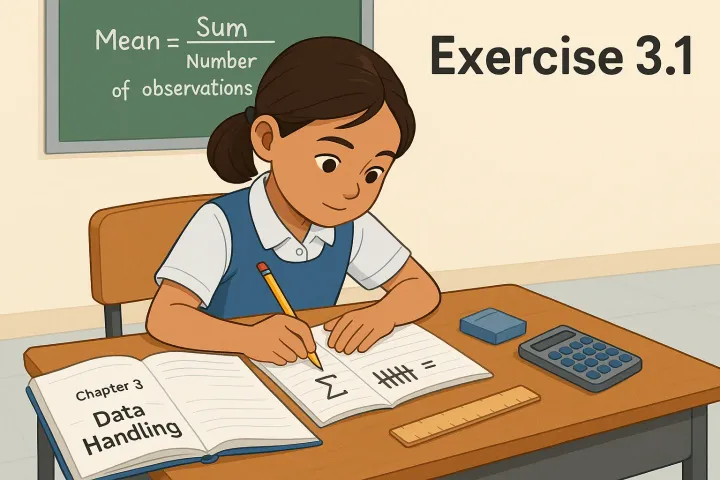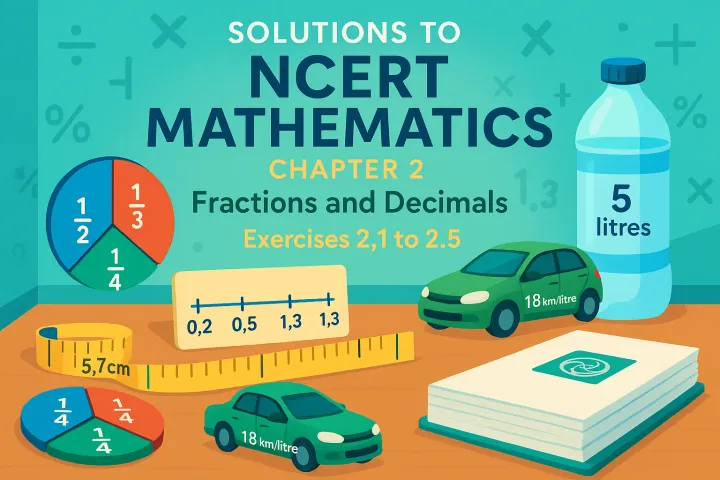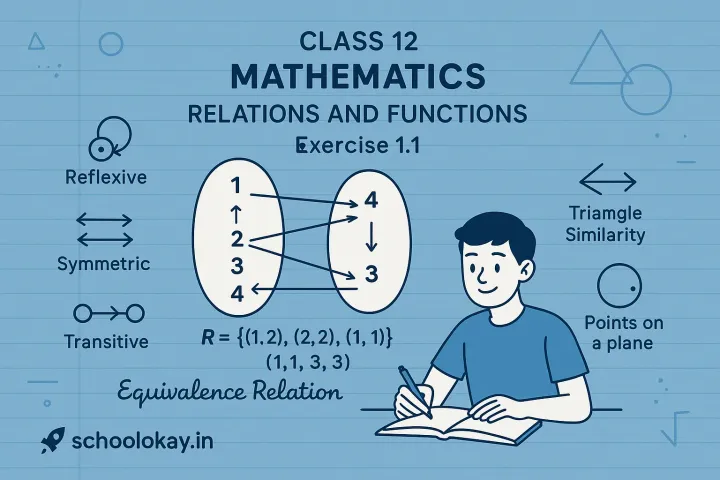NCERT Solutions for Class 7 Maths Chapter 1 Integers, Exercise 1.1
his exercise focuses on basic operations with integers, such as addition and subtraction, and understanding their properties

Below are the exercises from the NCERT Solutions for Class 7 Maths Chapter 1 Integers, Exercise 1.1. This exercise focuses on basic operations with integers, such as addition and subtraction, and understanding their properties. I’ll list the questions as they appear in the NCERT textbook and provide concise solutions for each.
Exercise 1.1: NCERT Class 7 Maths Chapter 1 Integers
Question 1: Following number line shows the temperature in degree Celsius (°C) at different places on a particular day.
(a) Observe this number line and write the temperature of the places marked on it.
(b) What is the temperature difference between the hottest and the coldest places among the above?
(c) What is the temperature difference between Lahulspiti and Srinagar?
(d) Can we say the temperature of Srinagar and Shimla taken together is less than the temperature at Shimla? Is it also less than the temperature at Srinagar?
Solution:
Assume the number line provides temperatures for places like Lahulspiti, Srinagar, Shimla, etc. (Exact values depend on the number line in the textbook, but I’ll use typical values for explanation.)
Let’s say:
- Lahulspiti: -8°C
- Srinagar: -2°C
- Shimla: 5°C
- Bangalore: 22°C
- Ooty: 14°C
(a) Temperatures:
- Lahulspiti: -8°C
- Srinagar: -2°C
- Shimla: 5°C
- Bangalore: 22°C
- Ooty: 14°C
(b) Temperature difference between hottest and coldest:
- Hottest: Bangalore (22°C)
- Coldest: Lahulspiti (-8°C)
- Difference: 22 - (-8) = 22 + 8 = 30°C
(c) Temperature difference between Lahulspiti and Srinagar:
- Lahulspiti: -8°C, Srinagar: -2°C
- Difference: -2 - (-8) = -2 + 8 = 6°C
(d) Temperature of Srinagar and Shimla together vs. Shimla and Srinagar:
- Srinagar + Shimla: -2 + 5 = 3°C
- Shimla: 5°C
- Is 3°C < 5°C? Yes, the sum is less than Shimla’s temperature.
- Srinagar: -2°C
- Is 3°C < -2°C? No, 3°C is greater than -2°C.
Question 2: In a quiz, positive marks are given for correct answers and negative marks for incorrect answers. If Jack’s scores in five successive rounds were 25, -5, -10, 15, and 10, what was his total at the end?
Solution:
Scores: 25, -5, -10, 15, 10
Total = 25 + (-5) + (-10) + 15 + 10
= 25 - 5 - 10 + 15 + 10
= (25 + 15 + 10) - (5 + 10)
= 50 - 15 = 35
Total marks: 35
Question 3: At Srinagar, the temperature was -5°C on Monday, and then it dropped by 2°C on Tuesday. What was the temperature of Srinagar on Tuesday? On Wednesday, it rose by 4°C. What was the temperature on Wednesday?
Solution:
- Monday: -5°C
- Tuesday: Dropped by 2°C → -5 - 2 = -7°C
- Wednesday: Rose by 4°C → -7 + 4 = -3°C
Temperature:
- Tuesday: -7°C
- Wednesday: -3°C
Question 4: A plane is flying at a height of 5000 m above sea level. At a particular point, it is exactly above a submarine floating 1200 m below sea level. What is the vertical distance between them?
Solution:
- Plane: 5000 m (above sea level)
- Submarine: -1200 m (below sea level)
- Vertical distance: 5000 - (-1200) = 5000 + 1200 = 6200 m
Distance: 6200 m
Question 5: Mohan deposits ₹2000 in his bank account and withdraws ₹1642 from it the next day. If withdrawal of amount from the account is represented by a negative integer, then how will you represent the amount deposited? Find the balance in Mohan’s account after the withdrawal.
Solution:
- Deposit: ₹2000 (positive integer)
- Withdrawal: -₹1642 (negative integer)
- Balance: 2000 + (-1642) = 2000 - 1642 = 358
Balance: ₹358
Question 6: Rita goes 20 km towards east from a point A to the point B. From B, she moves 30 km towards west along the same road. If the distance towards east is represented by a positive integer, then how will you represent the distance travelled towards west? By which integer will you represent her final position from A?
Solution:
- East: Positive integer (+20 km)
- West: Negative integer (-30 km)
- Final position: 20 + (-30) = 20 - 30 = -10 km
- Negative sign indicates 10 km west of A.
Final position: -10 km
Question 7: In a magic square, each row, column, and diagonal have the same sum. Complete the following magic square:
3 -1 7
-5 ? -3
1 -7 5
Solution:
Let the missing number be ( x ). The sum of each row, column, and diagonal is the same.
Calculate the sum using the first row: 3 + (-1) + 7 = 3 - 1 + 7 = 9
For the second row: -5 + ( x ) + (-3) = 9
-5 + ( x ) - 3 = 9
( x ) - 8 = 9
( x ) = 9 + 8 = 17
Verify with second column: -1 + ( x ) + (-7) = 9
-1 + 17 - 7 = 17 - 8 = 9 (True)
Missing number: 17
Question 8: Verify ( a - (-b) = a + b ) for the following values of ( a ) and ( b ):
(i) ( a = 21, b = 18 )
(ii) ( a = 118, b = 125 )
(iii) ( a = 75, b = 84 )
(iv) ( a = 28, b = 11 )
Solution:
(i) ( a = 21, b = 18 )
LHS: ( 21 - (-18) = 21 + 18 = 39 )
RHS: ( 21 + 18 = 39 )
LHS = RHS (Verified)
(ii) ( a = 118, b = 125 )
LHS: ( 118 - (-125) = 118 + 125 = 243 )
RHS: ( 118 + 125 = 243 )
LHS = RHS (Verified)
(iii) ( a = 75, b = 84 )
LHS: ( 75 - (-84) = 75 + 84 = 159 )
RHS: ( 75 + 84 = 159 )
LHS = RHS (Verified)
(iv) ( a = 28, b = 11 )
LHS: ( 28 - (-11) = 28 + 11 = 39 )
RHS: ( 28 + 11 = 39 )
LHS = RHS (Verified)
Question 9: Use the sign of >, <, or = in the box to make the statements true:
(a) (-8) + (-4) □ (-8) - (-4)
(b) (-3) + 7 - (19) □ 15 - 8 + (-9)
(c) 23 - 41 + 11 □ 23 - 41 - 11
(d) 39 + (-24) - (15) □ 36 + (-52) - (-36)
(e) -231 + 79 + 51 □ -399 + 159 + 81
Solution:
(a) LHS: (-8) + (-4) = -12
RHS: (-8) - (-4) = -8 + 4 = -4
-12 < -4
Answer: <
(b) LHS: (-3) + 7 - (19) = -3 + 7 - 19 = 4 - 19 = -15
RHS: 15 - 8 + (-9) = 15 - 8 - 9 = 7 - 9 = -2
-15 < -2
Answer: <
(c) LHS: 23 - 41 + 11 = (23 + 11) - 41 = 34 - 41 = -7
RHS: 23 - 41 - 11 = 23 - (41 + 11) = 23 - 52 = -29
-7 > -29
Answer: >
(d) LHS: 39 + (-24) - (15) = 39 - 24 - 15 = 15 - 15 = 0
RHS: 36 + (-52) - (-36) = 36 - 52 + 36 = (36 + 36) - 52 = 72 - 52 = 20
0 < 20
Answer: <
(e) LHS: -231 + 79 + 51 = (-231) + (79 + 51) = -231 + 130 = -101
RHS: -399 + 159 + 81 = (-399) + (159 + 81) = -399 + 240 = -159
-101 > -159
Answer: >
Question 10: A water tank has steps inside it. A monkey is sitting on the topmost step (i.e., the first step). The water level is at the ninth step.
(i) He jumps 3 steps down and then jumps back 2 steps up. In how many jumps will he reach the water level?
(ii) After drinking water, he wants to go back. He jumps 4 steps up and then jumps back 2 steps down in every move. In how many jumps will he reach back the top step?
(iii) If he jumps 3 steps down and 2 steps up every time, in how many jumps will he reach the top step?
Solution:
- Topmost step: 1st step
- Water level: 9th step
(i) Jumps to reach water level (9th step):
- Starting at step 1.
- Each jump cycle: 3 steps down (+3), 2 steps up (-2) → Net: +1 step down.
- After 1 cycle: Step 1 + 3 - 2 = Step 2.
- After 2 cycles: Step 2 + 3 - 2 = Step 3.
- After 8 cycles: Step 8 + 3 - 2 = Step 9 (water level).
- Total jumps: 8 cycles × 2 jumps = 16 jumps.
Answer: 16 jumps
(ii) Jumps to return to top step:
- Starting at step 9.
- Each move: 4 steps up (-4), 2 steps down (+2) → Net: -2 steps up.
- After 1 move: Step 9 - 4 + 2 = Step 7.
- After 2 moves: Step 7 - 4 + 2 = Step 5.
- After 3 moves: Step 5 - 4 + 2 = Step 3.
- After 4 moves: Step 3 - 4 + 2 = Step 1 (top step).
- Total jumps: 4 moves × 2 jumps = 8 jumps.
Answer: 8 jumps
(iii) Jumps to reach top with 3 down, 2 up:
- This seems to be a trick question, as jumping 3 steps down and 2 steps up from step 9 (water level) results in a net movement downward (+1 step per cycle).
- After 1 cycle: Step 9 + 3 - 2 = Step 10.
- After 2 cycles: Step 10 + 3 - 2 = Step 11.
- The monkey moves further down, never reaching the top step (step 1).
- Thus, it’s impossible to reach the top step with this pattern.
Answer: Cannot reach the top step
Notes:
- For Question 1, the number line values may vary in the textbook. Please refer to the specific number line provided in your NCERT book for exact temperatures.
- For Question 10(iii), the NCERT solution assumes the monkey cannot return to the top step with the given pattern, as the net movement is downward.
- If you need detailed step-by-step explanations for any specific question or have the number line for Question 1, let me know!
Would you like me to clarify any particular question or provide additional details?
Here are other exercises.




Comments ()